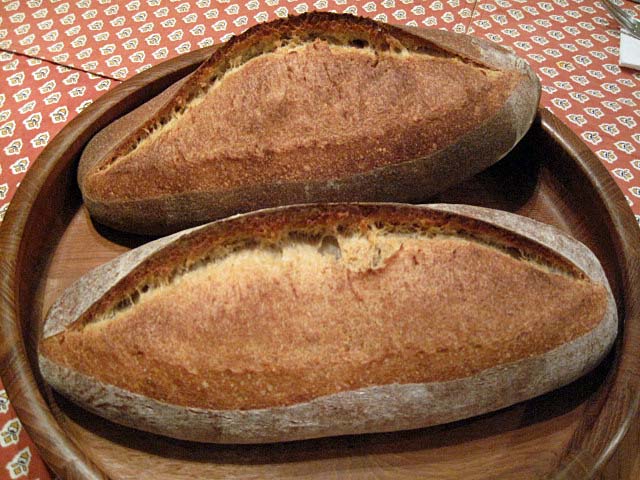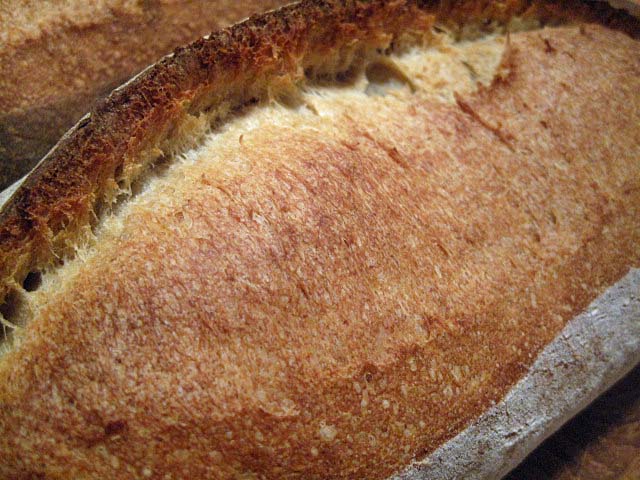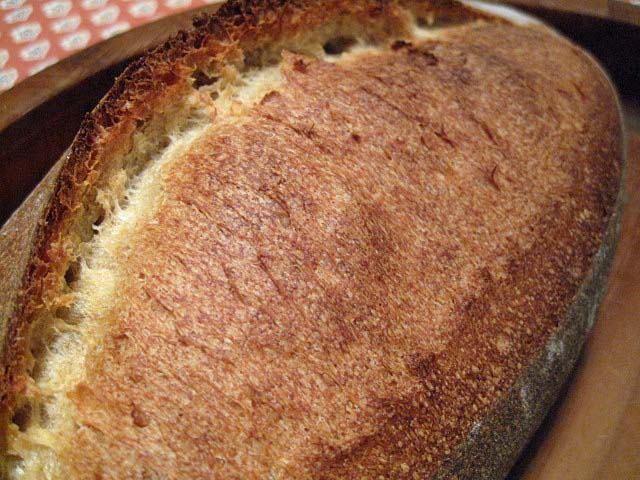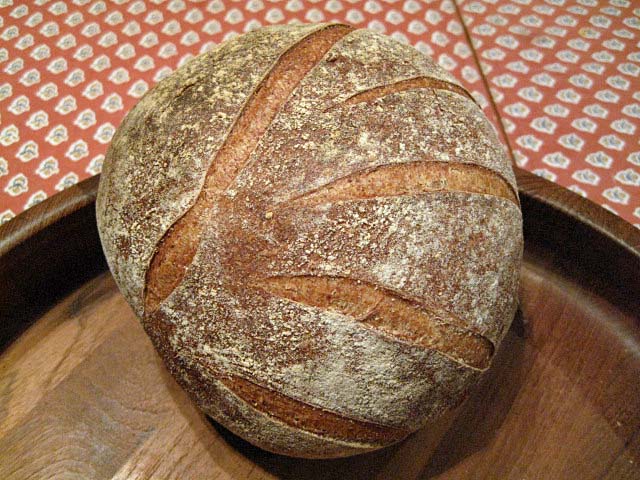
These are a couple of 755 gm bâtards of Hamelman's Pain au Levain I baked today. I think they illustrate the points made recently in discussions of scoring, ears and bloom, for example in Varda's topic To ear or not to ear.
To quote Michel Suas from Advanced Bread and Pastry again,
If the angle is not achieved and the cut is done with the blade vertical to the loaf, the two sides of the dough will spread very quickly during oven spring and expose an enormous surface area to the heat. The crust will begin to form too soon - sometimes before the end of oven spring - penalizing the development of the bread. If the cut is properly horizontal, the sides of the loaf will spread slower. The layer of dough created by the incision will partially and temporarily protect the surface from the heat and encourage a better oven spring and development. (Suas, pg. 116.)
These loaves were scored with a razor blade mounted on a metal lame. The blade was held at a 30º angle. The cuts were about 1/2 inch deep. I think the coloration of the bloom attests to the slow spread to which Suas refers.


I think you can clearly see three distinct colors in the bloomed crust, progressively lighter in color from right to left, with the lightest color being that under the ear. As the cut opens up during the bake, it does so slowly over a prolonged period. The darkness of the bloom demonstrates the length of time each area was directly exposed to the oven's heat. The ear keeps the area under it sheltered from the heat so it doesn't form a crust, but, as the bloom widens, the previously sheltered area becomes uncovered by the ear, and it begins to brown.
Scoring with the blade perpendicular to the loaf surface thus results in less bloom, and the blooming is terminated sooner in the bake. The coloration of the bloom is more uniform. An example - a Vermont Sourdough I also baked today:

I hope this helps clarify the point of the ear - how you get it and why you might want to.
David
Submitted to YeastSpotting
- dmsnyder's Blog
- Log in or register to post comments
Interesting David, when I am at work in a few moments I will consider this while I score some loaves.
I love the pain au levain by the way, very nicely done!
Another thing to aspire to. Oy, so many aspirations, so little time :)
great post! Does scoring too deeply at a shallow angle negatively affect the bloom at all, or does it just result in a more pronounced ear? I vaguely remember reading in Hamelman that too deep a score will cause the cut to "collapse under its own weight" or something to that effect (probably a gross misquote). I'm not sure if he was referring solely to vertical cuts, or if that statement applies to shallow cuts as well.
Your memory is good. This applies to scoring at a shallow angle.
If the scoring is too deep, the weight of the ear, as it forms, will make it collapse. The looser the dough, the greater the risk. Thus, higher hydration doughs should be scored more shallowly.
David
That one side of the cut shields the dough from heat.
Makes me think about the fan blowing in the oven as well. It might be advantageous to place the loaves in the oven so the fan cannot blow into the cut. The higher thicker side protecting the score from baking too soon as it expands.
Those loaves opened up wide! Beautiful!
I use conventional baking for the first part, until most of the bloom has occurred. Then I switch to convection baking to dry and crisp the crust.
For these loaves, I used steam and convention baking for 15 minutes of a 40 minute bake. The loaves continued to spring and bloom for at least 5 additional minutes after the switch to convection.
David
On color, again, it was Julia, I believe, where I first read of the three colors desired in a loaf. They are slightly different than as described by David, but they basically get at the same thing. They are the darkest, at the lip of the cut, then the overall color of the outer crust, then the overall color of the grigne, which David then accurately breaks down further.
I asked a French speaking correspondent about grigne. In general, the word refers to a facial expression such as a grimace or pucker. In baking, it refers to the area exposed by the cut. I was also interested to learn that there is a verb, grigner, meaning to cut or slash the loaf.
Re-reading Julia Child is always enlightening. Recall that, when Julia wrote about French bread, it was Professor Calvel speaking, in large part.
Re. grigne: And another French term for a lame is "grignette."
David
That's right, David. She was quite clear about the source. Her writing on baking remains among the best, and predates the entire artisan baking movement.
David, that's a very interesting theory about ears. But I wonder if pronounced ears could also be partly genetic.
Here's a picture of my San Francisco Country Sourdough:
Besides pronounced ears, you and I also share a well-developed ability to become perfectly fermented.
That's my lame explanation.
Glenn
How much dough do you pay for your jokes?
The ears are symptomatic of an obsessive attention to detail and striving for perfection. That might be genetic, but I think, like most traits, it also depends on good role models.
David
David, These pictures are a terrific way to make this point. And the bread looks terrific too. Thanks for posting. -Varda
...axis?
David,
I don't want to nitpick, but, after two years, scoring successfully and, especially, consistently continues to escape me. Your explanation is clear, and your arguement logical, but I'm still uncertain. Is your 30° angle referenced to the horizontal, or to the vertical? I've done it both ways, at varying depths of cut, with very mixed results.
Please, this is one of the most frustrating steps in my baking experiences.
David G
First, a confession: I didn't actually get out my protractor and measure the angle. However, I can assure you the angle at which I positioned the blade was between 20 and 45 degrees.
The angle in question is from the horizontal. In other words, if the blade were to be laid on the loaf, the angle would be zero.
I hope this helps.
David
I've watched countless videos of the experts scoring bread. Their hands move so fast, I've never been certain what the angle is. Like I said earlier, I've had very mixed success. Next time I bake I'll pay close attention to both the angle--from the horizontal--and the depth of the cuts.
Thanks, David
David G
Hi David,
Thanks for putting up such a good post on this aspect of the process.
Long ago, I read in Reinhat's Bread Bakers' Apprentice that he attributed 80% chance of success being down to dough quality, with the other 20% leftover for oven treatments.
As a homebaker, I'm never quite sure how much I agree with that assessment. With access to commercial equipment, I'd be a lot more inclined to go along with it.
Your all-round baking skills are evident in all your TFL posts, but this aspect of your baking is clearly one in which you particularly excel.
Best wishes
Andy
I'm humbled by your compliment.
I don't recall the Reinhart statement you quoted, but I'm sure I disagree. Without getting into quantifying their relative importance, I'd break down "dough quality" into mixing, fermentation and shaping (at least). And what about recipe formulation and quality of ingredients? I guess you could lump all of them into "dough quality," but I'm a "splitter." ;-)
David